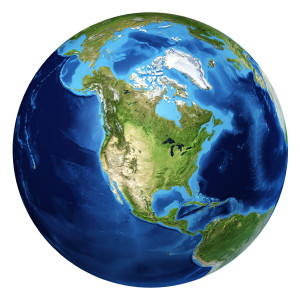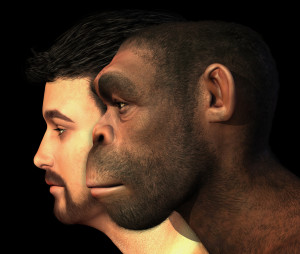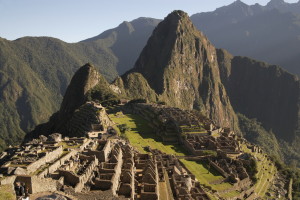About 60,000 years ago, modern man Homo sapiens started their migration out of Africa spreading throughout the Eurasian landmass foraging on the plants they gathered and the animals they hunted. They provided us with glimpses of their environment from Paleolithic paintings found on the walls and ceilings dating back some 17,000 years ago of horses, deer, and wild bulls they had encountered. Examples of these paintings can be found at such sites as Lascaux cave in France or Altamira in Spain. At Lascaux, most of the bones that littered the cave floor were that of reindeer which provides further testament to their consumption of meat. Altamira has the oldest known cave painting at 40,000 years ago.
About 20,000 years ago, hunter-gatherers followed the animal herds across the land bridge between present day Russia and Alaska flowing into Canada and the Americas. They relied on their stone tools to bring down large quarry, and to butcher the meat into manageable pieces that could be easily carried and consumed. A specialist in the evolutionary basis of diet and disease, Dr. Loren Cordain said in his book The Paleo Answer: “The Paleolithic period began 2.6 million years ago with the invention of primitive stone tools and ended with the beginning of the agriculture revolution about ten thousand years ago. During the Paleolithic Era, all of our ancestors lived as hunter-gatherers until the arrival of farming, animal husbandry, and permanent villages.”
 From the fossil records, scientists have determined that our hunter-gatherer ancestors were larger in size including their brains, athletic in build, had straight teeth with few if any dental cavities, void of chronic illnesses, cancer, and other modern diseases; and given a lifespan that would rival our own without the help of modern medicine. These physical attributes support the belief that they were receiving optimal nutrition from their diet. Their individual demise came from environmental factors such as: predators, infections due to injuries, and violence. In their book, The Protein Power Lifeplan: A New Comprehensive Blueprint for Optimal Health, doctors Michael and Mary Eades conclude that we are designed from natural selection to benefit from a diet that is 65% animal based and 35% plant-based. Paleolithic plant foods came from tubers, roots, rhizomes and some above ground sources such as mongongo nuts, coconuts and palm fruits. With ourselves having 99.995% identical genes, we have changed very little from our earliest ancestors.
From the fossil records, scientists have determined that our hunter-gatherer ancestors were larger in size including their brains, athletic in build, had straight teeth with few if any dental cavities, void of chronic illnesses, cancer, and other modern diseases; and given a lifespan that would rival our own without the help of modern medicine. These physical attributes support the belief that they were receiving optimal nutrition from their diet. Their individual demise came from environmental factors such as: predators, infections due to injuries, and violence. In their book, The Protein Power Lifeplan: A New Comprehensive Blueprint for Optimal Health, doctors Michael and Mary Eades conclude that we are designed from natural selection to benefit from a diet that is 65% animal based and 35% plant-based. Paleolithic plant foods came from tubers, roots, rhizomes and some above ground sources such as mongongo nuts, coconuts and palm fruits. With ourselves having 99.995% identical genes, we have changed very little from our earliest ancestors.
 The agriculture revolution, Neolithic period, started with the domestication of plants and animals. With the reliance on domesticated grains, modern man, Homo sapiens, had the ability to support larger cooperative groups of people living together that eventually became great cities. The picture on the left is that of Machu Picchu built high in the Andes mountains during the fifteenth century at the height of Inca rule in Peru. At this site, the Incas built 700-plus terraces into the mountain side to support agriculture, limit soil erosion, and conserve water. Corn and potatoes were Inca staples as well as peppers, tomatoes, avocados, peanuts and quinoa. For meat, the Incas ate guinea pigs, birds, fish and sometimes llamas and alpacas. Meat was considered a luxury.
The agriculture revolution, Neolithic period, started with the domestication of plants and animals. With the reliance on domesticated grains, modern man, Homo sapiens, had the ability to support larger cooperative groups of people living together that eventually became great cities. The picture on the left is that of Machu Picchu built high in the Andes mountains during the fifteenth century at the height of Inca rule in Peru. At this site, the Incas built 700-plus terraces into the mountain side to support agriculture, limit soil erosion, and conserve water. Corn and potatoes were Inca staples as well as peppers, tomatoes, avocados, peanuts and quinoa. For meat, the Incas ate guinea pigs, birds, fish and sometimes llamas and alpacas. Meat was considered a luxury.
Modern man’s earliest known cultivation of grains were that of barley and wheat which was used to make beer (go Guinness stout! My personal favorite beer, but yes it isn’t Paleo) and bread, respectively. But relying on grains to support humanity was not without cost as seen in the fossil records. These early farmers had bone malformations indicative of malnutrition, decreased height and brain case size, and many more dental cavities. Weston A. Price, DDS noted in his book Nutrition and Physical Degeneration when primitive Aborigines (Indians) were placed on a white man’s diet, they suffered “extremely” from tooth decay as did the whites. He traveled the globe during the 1930’s and documented similar findings with other aboriginal groups who no longer ate their traditional foods. Even today, we are witness to a health crisis that has its origins with the agricultural revolution.
Additional sources:
Cave Paintings – Exploring Prehistoric Europe by Chris Scarre
Machu Picchu– Wikipedia
A history of the Incas and their daily life by Tim Lambert
The Paleo Manifesto: Ancient Wisdom for lifelong health by John Durant
The Human Journey: Migration Routes
For my next post, I will begin to unravel the consequences of a grain based diet as experienced by those early farmers and what it means to us today.
As always, if you would like to comment about this post, then please share at myorigins@kenpldger.com or leave a comment below.
If you found the information helpful, please share with your friends and family.